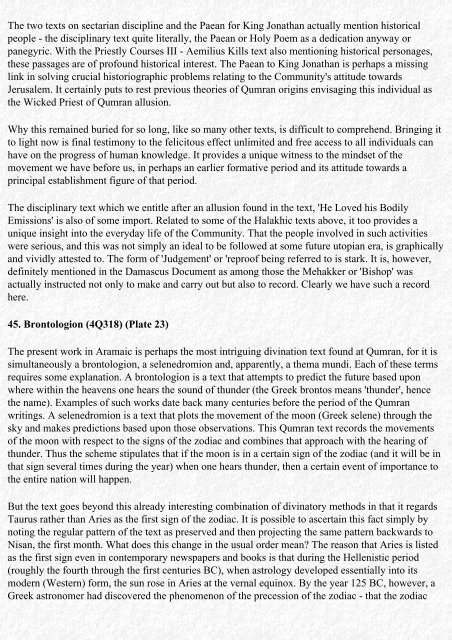Dead Sea Scrolls Uncovered - The Preterist Archive
Dead Sea Scrolls Uncovered - The Preterist Archive
Dead Sea Scrolls Uncovered - The Preterist Archive
Create successful ePaper yourself
Turn your PDF publications into a flip-book with our unique Google optimized e-Paper software.
<strong>The</strong> two texts on sectarian discipline and the Paean for King Jonathan actually mention historical<br />
people - the disciplinary text quite literally, the Paean or Holy Poem as a dedication anyway or<br />
panegyric. With the Priestly Courses III - Aemilius Kills text also mentioning historical personages,<br />
these passages are of profound historical interest. <strong>The</strong> Paean to King Jonathan is perhaps a missing<br />
link in solving crucial historiographic problems relating to the Community's attitude towards<br />
Jerusalem. It certainly puts to rest previous theories of Qumran origins envisaging this individual as<br />
the Wicked Priest of Qumran allusion.<br />
Why this remained buried for so long, like so many other texts, is difficult to comprehend. Bringing it<br />
to light now is final testimony to the felicitous effect unlimited and free access to all individuals can<br />
have on the progress of human knowledge. It provides a unique witness to the mindset of the<br />
movement we have before us, in perhaps an earlier formative period and its attitude towards a<br />
principal establishment figure of that period.<br />
<strong>The</strong> disciplinary text which we entitle after an allusion found in the text, 'He Loved his Bodily<br />
Emissions' is also of some import. Related to some of the Halakhic texts above, it too provides a<br />
unique insight into the everyday life of the Community. That the people involved in such activities<br />
were serious, and this was not simply an ideal to be followed at some future utopian era, is graphically<br />
and vividly attested to. <strong>The</strong> form of 'Judgement' or 'reproof being referred to is stark. It is, however,<br />
definitely mentioned in the Damascus Document as among those the Mehakker or 'Bishop' was<br />
actually instructed not only to make and carry out but also to record. Clearly we have such a record<br />
here.<br />
45. Brontologion (4Q318) (Plate 23)<br />
<strong>The</strong> present work in Aramaic is perhaps the most intriguing divination text found at Qumran, for it is<br />
simultaneously a brontologion, a selenedromion and, apparently, a thema mundi. Each of these terms<br />
requires some explanation. A brontologion is a text that attempts to predict the future based upon<br />
where within the heavens one hears the sound of thunder (the Greek brontos means 'thunder', hence<br />
the name). Examples of such works date back many centuries before the period of the Qumran<br />
writings. A selenedromion is a text that plots the movement of the moon (Greek selene) through the<br />
sky and makes predictions based upon those observations. This Qumran text records the movements<br />
of the moon with respect to the signs of the zodiac and combines that approach with the hearing of<br />
thunder. Thus the scheme stipulates that if the moon is in a certain sign of the zodiac (and it will be in<br />
that sign several times during the year) when one hears thunder, then a certain event of importance to<br />
the entire nation will happen.<br />
But the text goes beyond this already interesting combination of divinatory methods in that it regards<br />
Taurus rather than Aries as the first sign of the zodiac. It is possible to ascertain this fact simply by<br />
noting the regular pattern of the text as preserved and then projecting the same pattern backwards to<br />
Nisan, the first month. What does this change in the usual order mean? <strong>The</strong> reason that Aries is listed<br />
as the first sign even in contemporary newspapers and books is that during the Hellenistic period<br />
(roughly the fourth through the first centuries BC), when astrology developed essentially into its<br />
modern (Western) form, the sun rose in Aries at the vernal equinox. By the year 125 BC, however, a<br />
Greek astronomer had discovered the phenomenon of the precession of the zodiac - that the zodiac

















